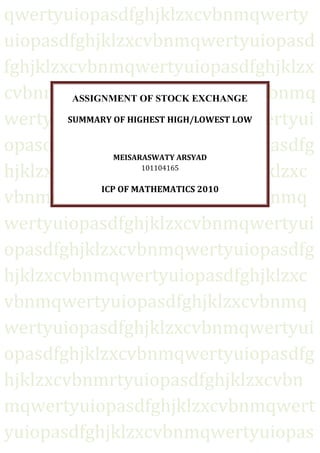08 101104165 meisaraswaty_arasyad_word
- 1. qwertyuiopasdfghjklzxcvbnmqwerty uiopasdfghjklzxcvbnmqwertyuiopasd fghjklzxcvbnmqwertyuiopasdfghjklzx cvbnmqwertyuiopasdfghjklzxcvbnmq wertyuiopasdfghjklzxcvbnmqwertyui opasdfghjklzxcvbnmqwertyuiopasdfg hjklzxcvbnmqwertyuiopasdfghjklzxc vbnmqwertyuiopasdfghjklzxcvbnmq wertyuiopasdfghjklzxcvbnmqwertyui opasdfghjklzxcvbnmqwertyuiopasdfg hjklzxcvbnmqwertyuiopasdfghjklzxc vbnmqwertyuiopasdfghjklzxcvbnmq wertyuiopasdfghjklzxcvbnmqwertyui opasdfghjklzxcvbnmqwertyuiopasdfg hjklzxcvbnmrtyuiopasdfghjklzxcvbn mqwertyuiopasdfghjklzxcvbnmqwert yuiopasdfghjklzxcvbnmqwertyuiopas ASSIGNMENT OF STOCK EXCHANGE SUMMARY OF HIGHEST HIGH/LOWEST LOW MEISARASWATY ARSYAD 101104165 ICP OF MATHEMATICS 2010
- 2. 1. Highest High/Lowest Low The study plots the highest high and the lowest low for the number of periods you specify. 2. Literatury View Propertie High: The Symbol field on which the study will be calculated. The application uses the Aspect "High". Low: The Symbol field on which the study will be calculated. The application uses the Aspect "Low". HighPeriod: The number of bars of the first Moving Average. If the chart displays daily data, then period denotes days; in weekly charts, the period will stand for weeks, and so on. If the default length of the indicator is chosen (Workstation uses a period of 10), the study will return the highest of the high price values / lowest of the low price values over the previous 10 bars. LowPeriod: The number of bars of the second Moving Average. If the chart displays daily data, then period denotes days; in weekly charts, the period will stand for weeks, and so on. If the default length of the indicator is chosen (Workstation uses a period of 10), the study will return the highest of the high price values / lowest of the low price values over the previous 10 bars. The rules generally followed for this study are: enter the market when one of the bands is penetrated. This indicates a possible start of a trend. exit and reverse the position when the opposite band is penetrated. Another rule you may want to apply is the Donchion’a rule, which states: cover short positions and go long whenever the price exceeds the high of the previous four weeks. reverse long positions and go short whenever the price exceeds the low of the previous four weeks.
- 3. 3. Calculation The mathematics define an envelope of values by using the highest high and lowest low over a duration of n periods. Formula HHt = Highest High of period LLt = Lowest Low of period Ht = High for current bar Lt = Low for current bar High-Low Projections A High-Low projection is plotted as a channel around the chart. It is used to generate support and resistance levels, with the understanding that if the price breaks through either of these levels, the market has entered a new trend. The Formula is: Res = ((hi+lo+cl)/3)*2 Projected high for next day = res minus lo Projected low for next day = res minus hi The study is plotted as a channel, on top of the next day's ohlc bars. The calculation uses the True High and True Low. The True High is the greater of today's high price and yesterday's closing price. The True Low is the lesser of today's low price and yesterday's closing price. 4. Interpretation The mathematics defines an envelope of values by using the Highest High or the Lowest Low of the Last 'n' Periods. HHt = Max(Ht,Ht-1,...,Ht-n+1) LLt = Min(Lt,Lt-1,...,Lt-n+1)
- 4. Default Parameters: 10, 10 Period1: The number of bars in a chart. If the chart displays daily data, then period denotes days; in weekly charts, the period will stand for weeks, and so on. If the default length of the study is chosen (10), the study will return the highest of the high price values over the previous 20 bars. Period2: The number of bars in a chart. If the chart displays daily data, then period denotes days; in weekly charts, the period will stand for weeks, and so on. If the default length of the study is chosen (10), the study will return the lowest of the low price values over the previous 10 bars. Sample Chart: 5. Graph analysis Highest High/Lowest Low (HILOW) The study plots the highest high and the lowest low for the number of periods you specify. Parameters: HighestHigh Period (20) - the number of bars, or interval, used to determine the highest high. LowestLow Period (10) - the number of bars, or interval, used to determine the lowest low. Computation The mathematics define an envelope of values by using the highest high and lowest low over a duration of n prior periods. There are a number of variations of the "barchart style" chart available on the web site.
- 5. High/Low Close Chart - plots a line from the high to the low price for the day. The line from the closing price to the high price is plotted in red. The line from the closing price to the low price is plotted in blue. 6. Conclusion a. Adventages Easy in application b. Disadventages Another disadvantage of the high-low method is the number of steps necessary to perform this analysis. The accountant needs to gather monthly data regarding the expense being analyzed and the unit of activity. The accountant lists each set of data and identifies the high and low values. She calculates the difference between these sets of values. She divides the difference in dollars by the difference in activity to calculate the cost per unit of activity, or the variable activity. She multiplies the variable cost per unit by the number of activities to calculate the total variable cost. She subtracts the total variable cost from the total cost to determine the fixed cost. Each additional step increases the potential for errors. not accommodate all the coordinates so that no data are available that are not represented






